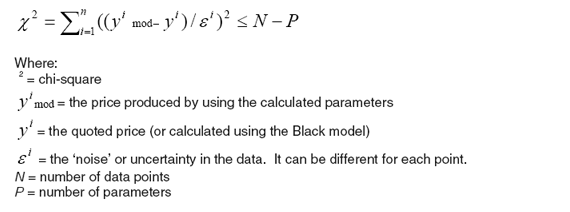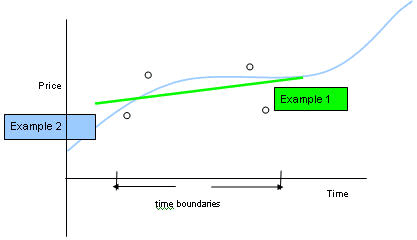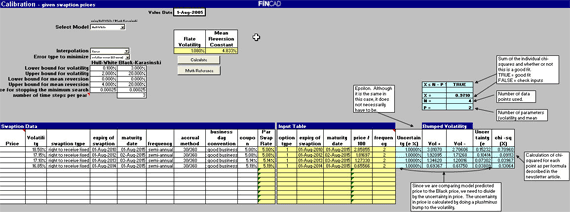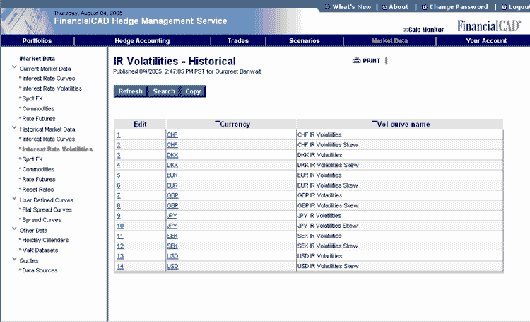A calibrated model is a model whose parameters have values that are consistent with market observations. Calibration involves finding values of parameters such that the model is able to reproduce (as close as possible) the prices of the "calibration instruments" observed in the market. Within FINCAD, calibration is a necessary step to value numerous instruments including swaptions, callable bonds and other structured instruments. Calibration of a short rate model is the process of determining the short rate volatility and mean reversion parameters. These parameters are determined from market data of actively traded options (swaptions and/or caps/floors).
FINCAD supports the following one factor short rate models: Ho-Lee, Hull-White, Black-Karasinski and Lognormal. FINCAD also supports multi-factor and LIBOR market model calibration although these will not be discussed in the article.
To download the latest trial version of FINCAD Analytics, contact a FINCAD Representative.
Types of Data Used in Calibration
The instruments used in the calibration should be as similar as possible to the instrument being valued. In general you would want to have caps/floors or swaptions that mature or fall on the important dates (cashflow dates or call/put) of the underlying instrument that you are trying to value. For example, to value a Bermudan swaption that is exercisable beginning five years from today to nine years, into a swap with maturity ten years from today, you would use European swaptions with the following maturities: 5x5; 6x4; 7x3; 8x2; 9x1.
Another example would be an American exercise callable bond maturing in 10 years that can be exercised starting today. Some sample European swaptions to use would be: 1x9; 2x8; 3x7; 4x6; 5x5. Additional criteria that should be considered is that some of the instruments used for calibrating may not be actively traded instruments (stale quotes). For what constitutes good calibration, please see below.
FINCAD supports the use of either market quoted ATM European swaptions or caps and floors. For calibration using caps and floors the inputs that are required are caplets and floorlets. Since data for caplets and floorlets is not likely to be available, the function aaVol_Crv2_Rcap_BL can be used to bootstrap the necessary data.
What is Good Calibration?
Calibration is as much an art as it is a science and therefore it is necessary to pick a test that one feels will measure the validity of the calibrated results. One possible test is a goodness of fit or chi square test. Basically, this test takes the difference between the underlying price as quoted and the calibrated price divided by an uncertainty factor and squares this result. Finally sum up all of the squares. The test objective is to compare this result to the difference between the number of data points and number of parameters.
Here is the formula:

In FINCAD XL Version 8 this can be done by looking at the pre-built workbook FINCAD XL > Workbooks (User Data) > Calibration > Calibration (BK or HW using swaptions), columns P (price / 100) and U (swaption price check). Column P values the swaption using the Black model while column U values the swaption using the calibrated short rate volatility and mean reversion. Using these values, we can perform the chi square test to calculate whether or not the calibration outputted good results. For more accurate results, you may need to discard or add some swaptions or increase the uncertainty factor. See the detailed example below:
Calibration Example: Bermudan Swaption
Exercise: Beginning five years from today to nine years and is exercisable into a swap maturing ten years from today.
Calibration Instruments: four swaptions: 5x5; 7x3; 8x2; 9x1
Results: short rate volatility of 1.080% and mean reversion of 4.833%.
Please see workbook below.
As can be seen in the screenshot below and in the workbook, the calculated chi-square is less than the difference between the number of data points and the parameters. This would seem to indicate a good fit.
Sometimes you may get unintuitive results. For example for Hull-White a volatility of 2% but mean reversion (MR) of 93%. The MR may seem incorrect but the goodness of fit may be good. The reason for this is that there may be several solutions for the model parameters that give an equally good fit to the data. For example, increasing the volatility of the short rate is countered by an increase in mean reversion, such that increasing both may result in another, equally valid solution. One must be aware however, that the model parameters are "tuned" over the time period of your calibration instruments. If you calibrate to 1x9, 2x8, …, 9x1 European swaptions, then your calibration is valid for pricing interest rate derivatives with similar tenor that mature in up to 10 years. The calibration may not be valid for pricing instruments that mature at a later date. That is, the various solutions for the model parameters may give good fits to the calibration data over the calibration time period, but outside the time period the fit could be poor.

As can be seen in the above example, the results of example one and two are very good for the range defined by the two lines on the X-axis. However, outside of the range, Example 2 likely has poor results. Therefore as long as the underlying instrument is within this range, the results should be consistent.
Now That I Know What Calibration Is, Where Do I Get the Data?
Data can be found from many third party data providers including FINCAD Market Data and Bloomberg Finance LP*.
1) FINCAD Market Data:
FINCAD provides end of day swaption and cap/floor volatility data for major currencies including USD, EUR, GBP and CAD (see below). Daily data is available historically, beginning from December 1999. For a complete list of currencies and further information please visit our website at www.fincad.com and sign up for a free trial registration of The Perfect Hedge.
2) Bloomberg Finance LP:
The various currencies that Bloomberg Finance LP has data for can be found by going to the WCV screen, selecting the currency and then selecting 'Swaption Volatilities' or 'Cap/Floor Rates.'
Please note that automatic DDE links can also be embedded into the FINCAD calibration workbook.
Disclaimer
Your use of the information in this article is at your own risk. The information in this article is provided on an "as is" basis and without any representation, obligation, or warranty from FINCAD of any kind, whether express or implied. We hope that such information will assist you, but it should not be used or relied upon as a substitute for your own independent research.
For more information or a customized demonstration of the software, contact a FINCAD Representative.
* Bloomberg is a trademark of Bloomberg Finance LP. FINCAD is not associated in any way with Bloomberg Finance LP.


